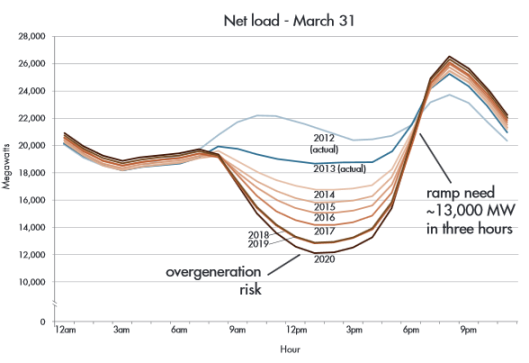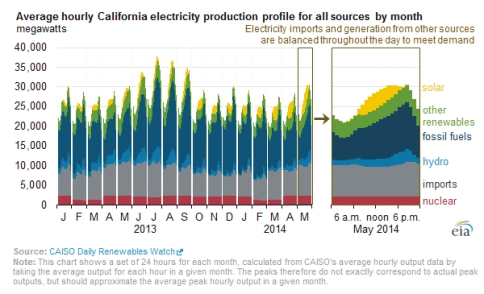

Duck Curve
As we march along with the nation’s rather massive build-out of renewable energy resources, questions emerge for how to fill the gaps when the sun sets and the wind stops blowing – i.e., when it’s nice to be outdoors, especially in the summer. So there you have it – turn off the lights, grab a drink and go out on the deck to hang out with your friends and family. Now there is a behavior program to get behind! Patent underway. Unfortunately, the discussion is focused on energy storage rather than “quality time”, a term that predates “work-life balance”.
Once again the duck curve is provided for reference, courtesy of the California Independent System Operator or CAISO. CAISO has an excellent page where visitors can see the duck being drawn every day in real time, here.
As for energy, most readers probably think electricity, natural gas, petrol, some renewables, and possibly 5 Hour Energy. An engineer coming out of engineering school better have a much broader list of types of energy.
- Electricity
- Fuels: Fossil and nuclear fuels can be burned or fissioned to produce heat which can be used to generate power and provide process and space heating.
- Kinetic: This is available energy in a moving object. A spinning flywheel is a common type of this – used for pile drivers, for one, and is also an electric energy storage technology.
- Potential: generally a result of changing elevation. Hydro power stations are a common form of converting potential energy to power.
- Thermal: Heat is probably the lowest form of energy because it is the least convertible. All types of energy when released dissipate as heat sooner or later.
- Chemical: This is the least understood by me. You, for example, exist at 98.6 degrees while your surroundings, if inside, are probably 70-75 degrees. You constantly need to reject heat because of non-combusting chemical reactions occurring in the body.
- Electro-chemical – batteries of all types.
As part of our internal training for engineers who conduct energy audits, retro-commissioning, and feasibility studies, I say, think! Graduating engineers and even those who’ve been in the business a while are trained to calculate answers. Schooling unfortunately does not come with a heavy dose of critical thinking. Critical thinking includes asking the critical questions for potential solutions.
Identifying energy-saving opportunities is one thing. However, Lucifer lurks in the shadows of an apparent great solution. How will it be controlled? Is there space for it? Is the structure to support it strong enough? What will it cost to get power and/or natural gas to the thing? Is the owner going to hate looking at that thing on the roof or in front of the building? These are just a very few critical questions one has to think about and oftentimes, this phase buries projects from a cost-effective or other go / no-go decision.
As an engineer, I look at the duck and I look at my forms of energy. I read what’s under development in the industry for energy storage to mitigate the roly poly duck curve and I say to myself, “Is anyone thinking?!”
Batteries are really cool for this laptop, my iPad and iPhone, but they probably don’t hold enough energy to toast a piece of bread. They are very expensive Watt-hour storage mediums. I first introduced the concept of utility-scale battery storage back in Energy Storage – Something Old, Something Old.
Think big or go home. We can either store the commodity itself or we can store what the commodity does for us. This is the punchline.
The technology is older than batteries and older than the utility industry: ice! This was discussed in Wind Energy – Finally Going Somewhere. Energy storage to supplement the grid can include several types for several reasons. One need is day-to-day peak shaving or shifting. We can do that with batteries or we can do that with far less-expensive ice.
Note, the duck curve is for a typical March day. Why March? Probably because it shows the sharpest ramp down and ramp up required from non-renewable resources – and it makes a pretty picture??

Summer Curve for California
I finally found summer curves, shown in the chart, for California.
Thermal energy storage is comparatively cheap, or even free. Any frozen food storage facility is a giant thermal storage system ready to go for practically free. Especially where super-peak rates exist for shorter than 12 hours per day – because certainly per the charts above, the real peak period is much shorter than the 12 hours noted on the typical electric tariff. Many frozen food warehouses can be driving product temperatures down off peak and coast through the super peak with little need for mechanical cooling.
Conventional thermal energy storage can cost nothing. Ice storage can directly offset the cost of chillers. Like power plants, it is best to use the asset at 100% utilization and that’s what ice (and other types as well) allows owners to do. Ice storage offsets cooling equipment capacity. But even so, ice storage systems per my surveys cost about $100-$150/kWh of storage, and of course it is used over and over and over. This does not include chiller capacity offsets. Comparatively, I found this report by Purdue University indicating battery storage costs are about three to four times the expense per kWh. This is a lot better than I had guessed.
I have more to say about energy storage – for later.
